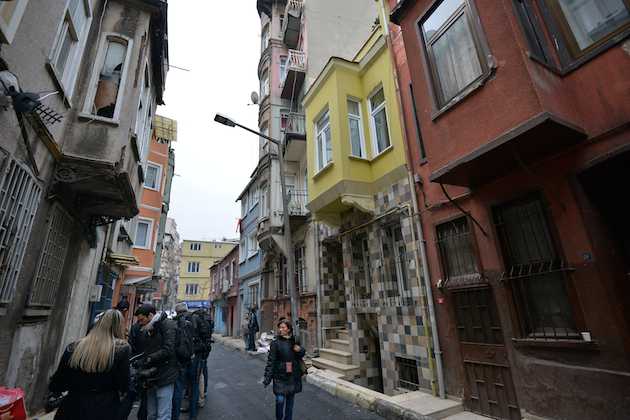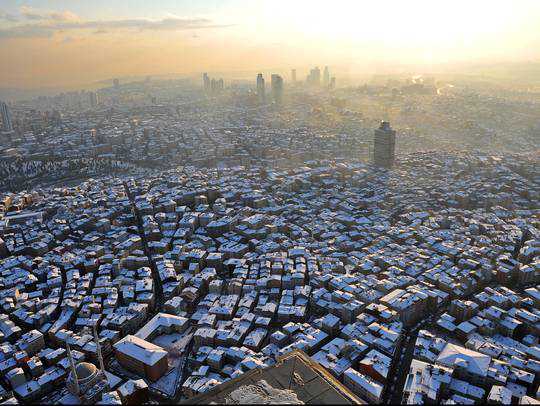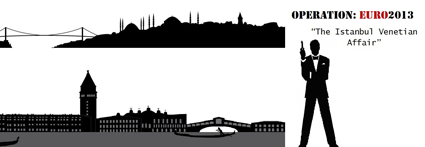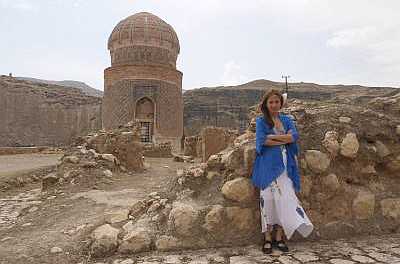Where time stood still: The writer in front of the Mausoleum of Zeynel Bey in Hasankeyf.
Even to adventurers, south-eastern Turkey is terra incognita. However, those who dare tread its lesser-known roads will be greatly rewarded – with pistachios, smiles and soul-searing sights.
THE red flag appeared in the periphery of the world news section of a local daily: “Car bomb kills one, wounds 18 in south-eastern Turkey.”
But I knew it was too late to turn back. My flight and hotels had been booked and, besides, hadn’t I always longed to go on an exciting adventure before I hit the big Three O?
So it was with no small degree of trepidation that I set off on a bus ride through one of the world’s last tourism frontiers, southeastern Turkey (or Turkish Kurdistan, if you like). Bordered by Syria to the south and Iraq to the southeast, this landlocked region is PKK (Kurdistan Workers’ Party) territory and a no-man’s land.
For nearly two decades, this was the epicentre of the Kurdish rebellion. Coupled with harsh weather, Third World infrastructure and scant tourist facilities, southeastern Turkey was off-limits to travellers and Turks from Western Anatolia.
Until recently, that is. Security levels are improving.
The New York Times listed Kurdistan as No 34 on its list of 41 places to travel in 2011 (it beat Budapest and Miami). However, this has had little effect on tourism numbers – only hardy backpackers and die-hard adventurers trickle in by the handful.
As my bus wound its way around the barren wilderness punctuated by the occasional desiccated shrub, I saw Mother Nature flaunt her assets. Around me were sheer sandstone cliffs dropping precipitously into nowhere and deserted hilltop citadels tinted golden by the unrelenting sun.
Harran, one of the world’s oldest continuous inhabited spots, where traditional mud brick ‘beehive’ houses still stand.
Sand soon gave way to concrete as the bus rumbled past rows of unsightly apartment blocks that scars nearly every town, signalling that we were close to Urfa, one of Southeastern Anatolia’s largest towns. Nearby was an army checkpoint, surrounded by menacing barb wires and sandbags piled high – an intimidating sight even to the bravest soul.
Nonetheless, I waved at the weary-faced soldiers, curious to see how they would respond. They waved back, all smiles.
Once the stomping ground of Prophet Abraham, Urfa is replete with biblical and Quranic lore and ancient Islamic edifices. Its proximity to Syria also means that the city radiates a distinctly Arabic vibe. With the muezzin’s call to prayer as background track, women clad in hijab and burqa and mustachioed men in keffiyeh (loose robes) clutching prayer beads go about their daily lives.
As the only East Asian around, I felt as conspicuous as a human on a planet filled with eight-legged ETs. Then I saw a little girl staring open-mouthed at me.
“Mama, too-rist!” yelped another little girl, tugging urgently at her mother’s shirt-sleeves.
“Merhaba (Hello)!” greeted mother and daughter in unison, eyes sparkling with curiosity. Witnessing the scene, another local ambled over with some apple-flavoured tea and watched in amusement as I gingerly took a sip.
Ancient wander
Just like the centuries of visiting pilgrims before me, I started by paying my respects to the great prophet in Golbasi, one of the few green lungs in the city. Golbasi isn’t just any park however – this was the place where Prophet Abraham and monotheism was born.
The story goes like this: Nimrod, the local Assyrian King, received a prophetic dream that a child would be born who would overthrow his rule. As a result, he had every baby in his kingdom killed except for Abraham, who was hidden in a nearby cave. When Abraham was discovered years later, Nimrod tried to cast him into a burning pit. But God saved Abraham by turning flames into water and the firewood to carp.
A boy selling simit, or Turkish-style pretzel, in the Urfa’s historic bazaar.
These days, it is considered auspicious to feed the thousands of sacred carp that still live in the pools in Golbasi.
Then I dove headlong into Urfa’s bazaar, with its tangle of narrow streets lined with copper craftsmen and chain-smoking vendors who hawk everything from spices and sheepskins, to jeans and ceremonial costumes. Built in the mid-16th century by Suleiman the Magnificent, the bazaar is the go-to place for bargain-loving locals.
Wandering past the bedesten (a covered market built during the Ottoman period), where fabrics were sold, I found myself in a busy courtyard filled with the click-clacking sounds of dice and backgammon being played by tea-swilling men. A boy walked among them, balancing a large tray piled high with simit, or Turkish-style pretzels, on his head.
Everything is delightfully antique in these parts, and Urfa and its surroundings are no exception. Six miles from there is Göbekli Tepe, one of the most startling archaeological discoveries of our time: massive monoliths that the National Geographic described as “vaguely similar to Stonehenge, except that Göbekli Tepe was built much earlier and is made not from roughly hewn blocks, but from cleanly carved limestone pillars splashed with bas-reliefs of animals – a cavalcade of gazelles, snakes, foxes, scorpions, and ferocious wild boars.”
As my tour guide Uraz Nehir and I straggled up the hill where Göbekli Tepe is situated, we began talking about the PKK and their crippling effects on the region’s economy.
“There were talks of ceasefire, but the fights resumed five or six months ago,” said Nehir, a fiercely patriotic and progressive Ankara-born Turk in his 20s.
“Many Kurdish themselves do not approve of the PKK. Too many innocent lives are lost; people just want to live normally.”
Nehir, who has visited this region a few times, claimed tour guides are paid extra money for tours to southeastern Turkey because of the “long bus rides” and “unpredictability”. Thankfully, our journey was disrupted only once when the UK government issued a warning on one of the highways we were supposed to take.
It was reported that the PKK had been rigging the highway’s petrol kiosks with explosives. Consequently, we had to take a 10-hour detour.
“If there is a fight, we change our route. So far, nothing bad has happened and I’m still alive,” he said. “Don’t worry!”
Disappearing act
Pointing to several foreign archaeologists excavating under the cloudless sky, Nehir said, “The oldest history in the world is written in this part of Anatolia. That’s what makes it so special.”
My heart skipped a beat. Here I was, at – some say – the original site of the Garden of Eden.
In the opinion of Klaus Schmidt, the German archaeologist who has been working here more than a decade, Göbekli Tepe was the site of the world’s first temple.
From there, we travelled to Mount Nemrut National Park, home to the monuments of an ancient megalomaniac. The views from the bus were breathtaking.
Squat trees grew wildly in a river valley of spectacular proportions, and the occasional villager plodded by, leading his donkey. We stopped at a safe bend, and Nehir strode over to one of the bushes to grab – it seemed – a fistful of flower buds. It was only after he handed some to me that I realised that we were standing next to a cluster of pistachio trees.
The Turks call pistachios fistik, which is also slang for “hot babe” – a testament to how much they love it.
We arrived at Mount Nemrut after braving a bumpy, dusty and – to cap it all off – winding road up the mountains. Looming before us was the immense burial mound of King Antiochus, with its array of gigantic marble heads severed from their stone bodies. To reach the site, one had to climb for another mile on foot, but there were also donkeys at the foothill one could hire for a fee.
Intent on incinerating the calories from my two-week diet of kebab and baklava, I opted to scale the heights of the 50m super-structure. Soon, I came face-to-face with the big, broody heads that I had found so strangely compelling, even in photographs. The sun was starting to set, casting a rosy glow on the deities, among them Greek Gods, eagles, lions and the king himself.
One travel guide describes the Nemrut ensemble, which includes reliefs, a cave cistern and ruins of columns, as “one of the most awesome sights in all of Anatolia.”
It would be a shame if these edifices didn’t last. According to several media sources, Hasankeyf, for one, is destined to vanish beneath the waters of the Ilisu Dam, the largest hydropower project in Turkey, slated to be completed next year.
The proposed dam will flood an area from Batman to Midyat, drowning the historic site and several other archeological treasures, displacing 37 villages.
The Washington Institute, however, was optimistic over the project, claiming that the dam was imperative for counter-terrorism purposes.
“This area is pierced by canyons that run for tens of miles and are hundreds of feet deep. In fact, it would not be exaggerated to describe these canyons as sort of a ‘PKK highway’,” said its website.
And when it’s completed, the Ilisu dam would flood these canyons, blocking this “PKK highway”.
But these fierce rebels did little to ruin my amazing trip so far. We decided to celebrate our journey in a meyhane, a traditional bar playing Kurdish music.
The Turks are known to enjoy an occasional pint and jive, and anyone who can snap fingers and swivel their hips are welcome on the dance floor. As I boogied with my newfound friends, my worries evaporated, replaced by irrepressible feelings of joy.






